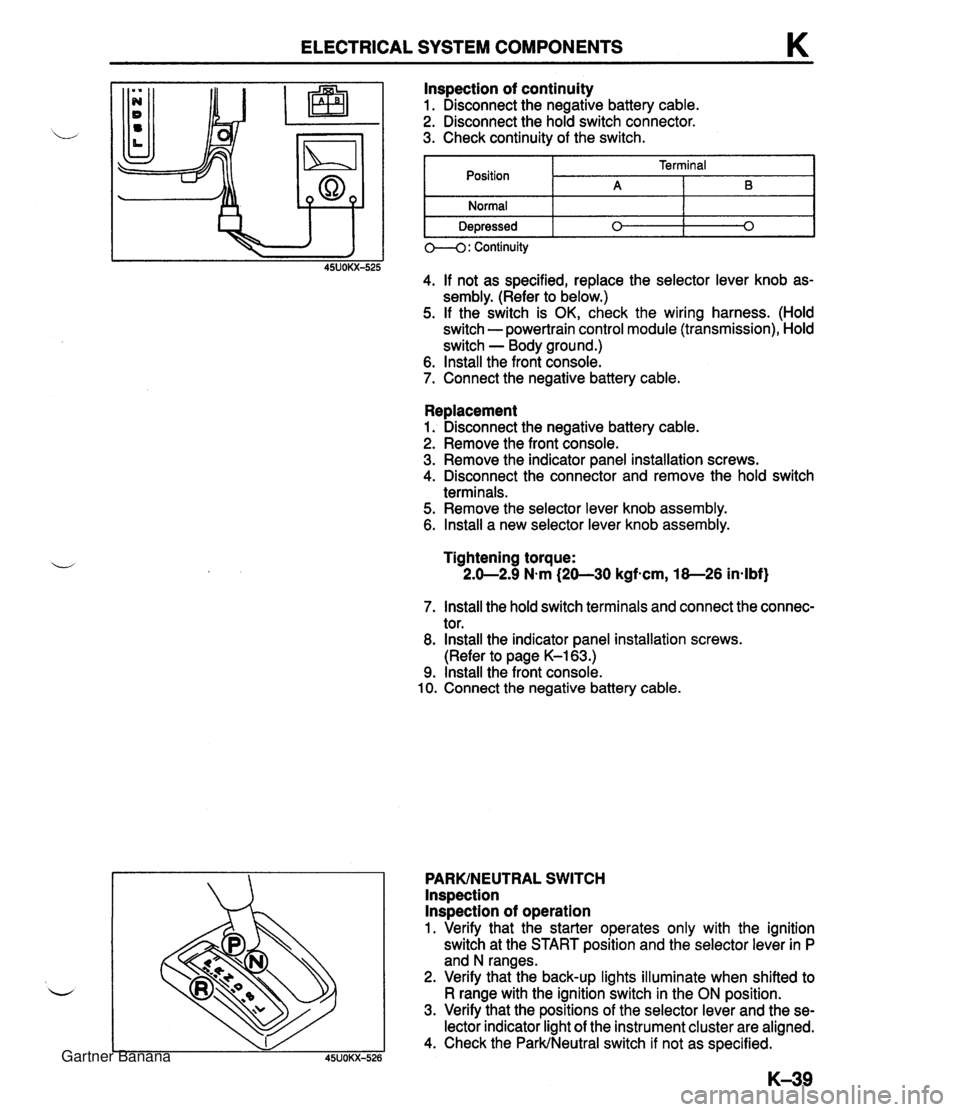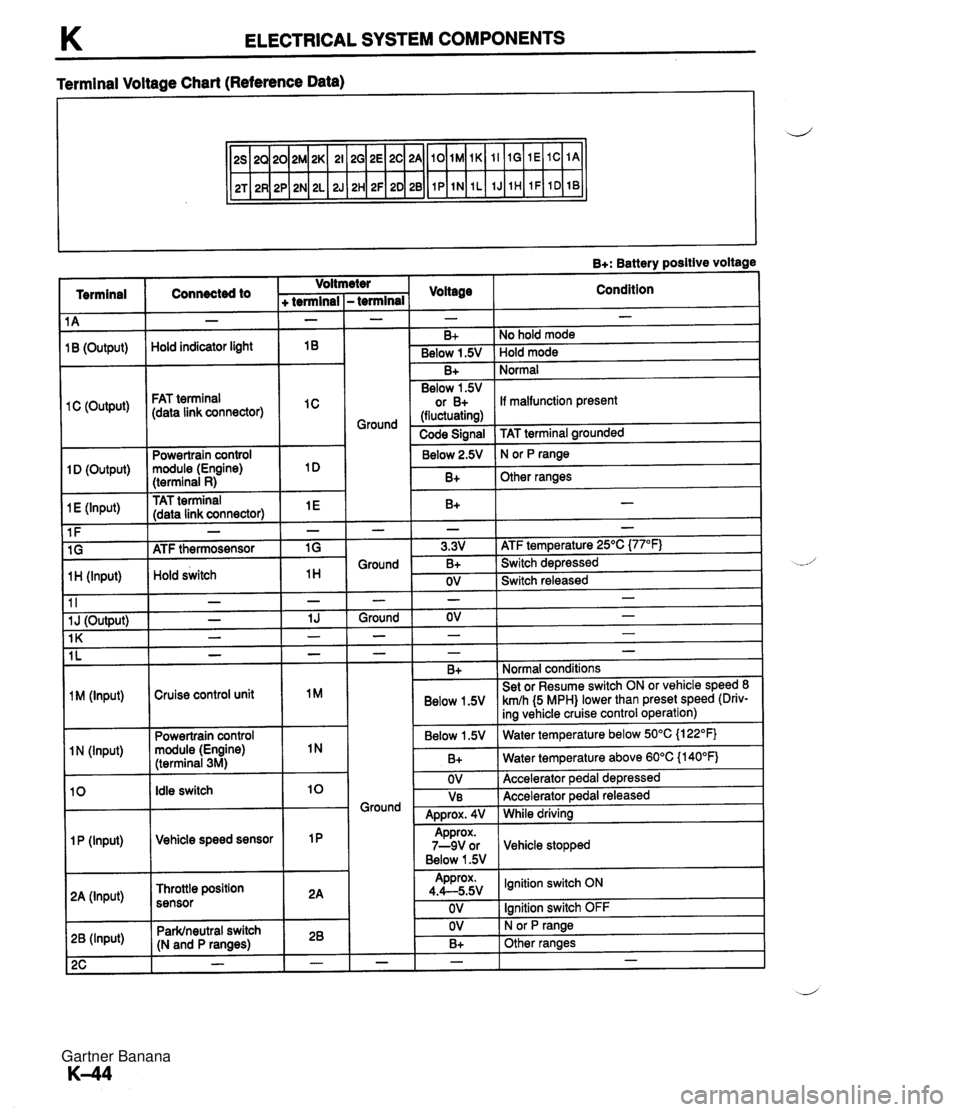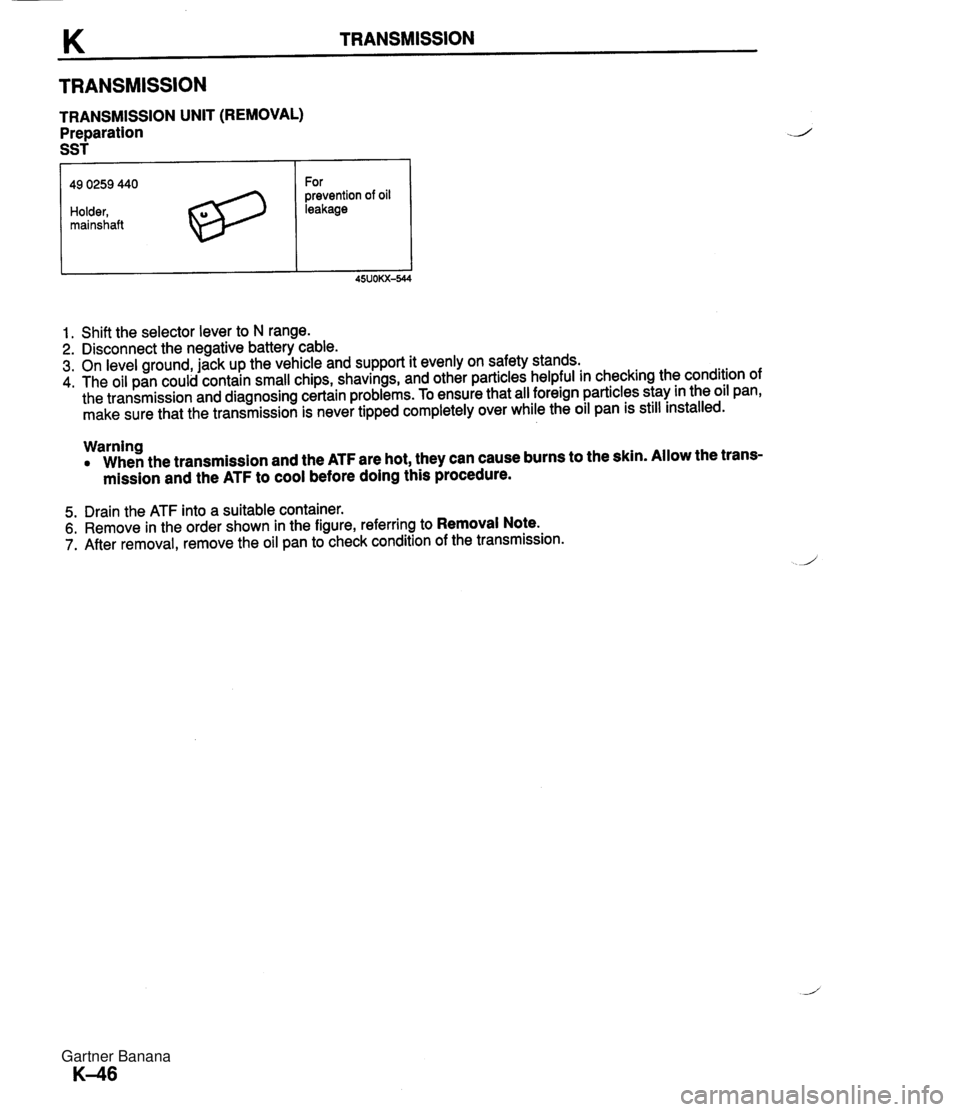battery MAZDA MX-5 1994 Workshop Manual
[x] Cancel search | Manufacturer: MAZDA, Model Year: 1994, Model line: MX-5, Model: MAZDA MX-5 1994Pages: 1708, PDF Size: 82.34 MB
Page 440 of 1708

ELECTRICAL SYSTEM COMPONENTS K Replacement 1. Disconnect the negative battery cable. 2. Remove the front console. 3. Remove the indicator panel installation screws. 4. Disconnect the connector and remove the hold switch terminals. 5. Remove the selector lever knob assembly. 6. lnstall a new selector lever knob assembly. lnspection of continuity 1. Disconnect the negative battery cable. 2. Disconnect the hold switch connector. 3. Check continuity of the switch. Tightening torque: 2.0-2.9 N.m (20-30 kgfscm, 18-26 in-lbf) Position Normal Depressed 7. lnstall the hold switch terminals and connect the connec- tor. 8. lnstall the indicator panel installation screws. (Refer to page K-163.) 9. lnstall the front console. 10. Connect the negative battery cable. PARKINEUTRAL SWITCH lnspection lnspection of operation 1. Verify that the starter operates only with the ignition switch at the START position and the selector lever in P and N ranges. 2. Verify that the back-up lights illuminate when shifted to R range with the ignition switch in the ON position. 3. Verify that the positions of the selector lever and the se- lector indicator light of the instrument cluster are aligned. 4. Check the ParkINeutral switch if not as specified. 0--4: Continuity 45UOKX-525 4. If not as specified, replace the selector lever knob as- sembly. (Refer to below.) 5. If the switch is OK, check the wiring harness. (Hold switch - powertrain control module (transmission), Hold switch - Body ground.) 6. lnstall the front console. 7. Connect the negative battery cable. Terminal A 0 B 0 Gartner Banana
Page 442 of 1708

ELECTRICAL SYSTEM COMPONENTS K ATF THERMOSENSOR Inspection 1. Refer to "Replacement" below for removal of the ATF thermosensor. 2. Place the ATF thermosensor in ATF with a thermometer as shown, and heat the ATF gradually. 3. Measure resistance between the terminals of the ATF thermosensor. ATF temperature- {OF) 1 Resistance (kR) 20 (68) 2.5 4. If not correct, replace the ATF thermosensor. 5. Refer to "Replacement" for installation of the ATF ther- mosensor. Replacement 1. Disconnect the negative battery cable. 2. On level ground, jack up the vehicle and support it evenly on safety stands. 3. Disconnect the ATF thermosensor connector. 4. Remove the ATF thermosensor. 5. Install the new ATF thermosensor. Tightening torque: 7.9-1 0.7 N-m (80-11 0 kgf-cm, 70-95.4 in-lbf) 6. Connect the ATF thermosensor connector. 7. Connect the negative battery cable. VEHICLE SPEED PULSE GENERATOR Inspection 1. Disconnect the negative battery cable. 2. On level ground, jack up the vehicle and support it evenly on safety stands. 3. Disconnect the vehicle speed pulse generator connec- tor. 4. Measure resistance between the terminals of the vehicle speed pulse generator. Resistance: 24552 5. If not correct, replace the vehicle speed pulse generator. 6. Connect the vehicle speed pulse generator connector. 7. Connect the negative battery cable. Gartner Banana
Page 443 of 1708

K ELECTRICAL SYSTEM COMPONENTS Replacement 1. Disconnect the negative battery cable. 2. On level ground, jack up the vehicle and support it evenly on safety stands. 4 3. Disconnect the vehicle speed pulse generator connec- tor. 4. Remove the vehicle speed pulse generator. 5. Install the new vehicle speed pulse generator. Tightening torque: 7.9--10.7 N-m (80-110 kgfecm, 70-95.4 in-lbf) 6. Connect the vehicle speed pulse generator connector. 7. Connect the negative battery cable. 1-2 SHIFT, 2-3 SHIFT, 3-4 SHIFT, 3-2 CONTROL SOLENOID VALVE Inspection 1. On level ground, jack up the vehicle and support it evenly on safety stands. 2. Disconnect the solenoid valve connector. d 3. Measure resistance between each terminal and ground. Resistance: l3-27a 4. If not correct, check the wiring harness for an open or short circuit. Replace the solenoid valve. Solenoid valve 1-2 shift 2-3 shift 3-4 shift 3-2 control LOCKUP CONTROL SOLENOID VALVE lnspection 1. Disconnect the solenoid valve connector. 2. Measure the resistance between the terminals. Terminal C D - A B Resistance: l3-2Sil 3. If not correct, replace the solenoid valve. Gartner Banana
Page 445 of 1708

K ELECTRICAL SYSTEM COMPONENTS Terminal Voltage Chart (Reference Data) C Terminal B+: Battery positlve voltage y Hold indicator light Condition Connected to 16 (Output) B+ Below 1.5V - - - No hold mode Hold mode FAT terminal (data link connector) I IC Voltage - - Voltmeter B+ Below 1.5V or B+ I C (Output) - - -- -- - - - -- -- - - - - - - - A- +terminal Normal If malfunction resent Ground (fluctuating) I Code Sianal I TAT terminal wounded -terminal Powertrain control module (Engine) (terminal R) TAT terminal (data link connector) - I - Below 2.5V 1 N or P range 1 D (Output) I Bt ]Other ranges I 1 E (lnput) 1 F 1 G I ATF thermosensor I 1G 3.3V ATF temperature 25OC {77"F) Ground B+ Switch depressed .-,/ -~ - 1 H (Input) 1 I Hold switch 1 OV ] Switch released I I 1 J (Output) 1 K 1 M (lnput) Cruise control unit I lM 1 N (lnput) Powertrain control module (Engine) (terminal 3M) 1 lN Idle switch B+ OV - -- Ve Accelerator pedal released I ADDrox. 4V While drivina Water temperature above 60°C {I 40°F) Accelerator pedal de~ressed Below 1.5V Vehicle speed sensor 1 P (lnput) 1 P I Approx' I Ignition switch ON I 4.4-5.5V 2A (Input) Throttle position sensor 1 2A . . . - . - . OV I lanition switch OFF 1 ParWneutral switch (N and P ranges) I OV I N or P ranae I 26 (Input) I B+ I Other ranaes I Gartner Banana
Page 446 of 1708

ELECTRICAL SYSTEM COMPONENTS K Terminal 2D (Input) 2E (Output) 2F (Input) 2G (Output) 2H (Input) - !I (Output) !J (Input)' - !K (Output) - !L (Ground)' 'M (Output) 1-2 shift solenoid valve 1 2E (S range) 2-3 shift solenoid valve Connected to Voltmeter I I +terminal . ParWneutral switch (D range) 2D - - (L range) 3-4 shift solenoid lalve Jehicle speed pulse 2J lenerator .ockup control ;olenoid valve 2K lehicle speed pulse 2L lenerator - 1 - I I - , - Z - 1 d - _4 3 V - - ower) E P (Ground) - 2P Ground ov - Q (Battery sattery 2Q B+ lgnition switch ON ower) OV Ignition switch OFF R - - - - - s (Battery Battery 2s B+ lgnition switch ON ~wer) Ground OV lgnition switch OFF Throttle position sen- 2T 'I- (Input) sor Approx. Throttle valve closed throttle position to wide 0.44.1 V open throttle Checked with AC range 1-2 control solenoid 'alve I 2M 1 ( Blow l.5V I 1 B+ 3-2 or 4-2 downshift OV Other conditions - - - I I I I lattery 20 B+ Constant Replacement Disconnect the negative battery cable. Disconnect the powertrain control module (Transmis- sion) connector. Remove the bolt and nut shown in the figure, and re- move the powertrain control module (Transmission). Install the new powertrain control module (Transmis- sion). Tightening torque: 19-25 N-m (1 .S2.6 kgf-m, 14--18 ftslbf) Connect the powertrain control module (Transmission). Connect the negative battery cable. Gartner Banana
Page 447 of 1708

TRANSMISSION TRANSMISSION UNIT (REMOVAL) Preparation SST 49 0259 440 Holder, mainshaft For prevention of oil leakage 1. Shift the selector lever to N range. 2. Disconnect the negative battery cable. 3. On level ground, jack up the vehicle and support it evenly on safety stands. 4. The oil pan could contain small chips, shavings, and other particles helpful in checking the condition of the transmission and diagnosing certain problems. To ensure that all foreign particles stay in the oil pan, make sure that the transmission is never tipped completely over while the oil pan is still installed. Warning When the transmission and the ATF are hot, they can cause burns to the skin. Allow the trans- mission and the ATF to cool before doing this procedure. 5. Drain the ATF into a suitable container. 6. Remove in the order shown in the figure, referring to Removal Note. 7. After removal, remove the oil pan to check condition of the transmission. Gartner Banana
Page 511 of 1708

K TRANSMISSION On-vehicle Removal 1. Disconnect the negative battery cable. 2. On level ground, jack up the vehicle and support it evenly on safety stands. 3. Remove the exhaust pipe. (Refer to page K-46.) 4. Remove the propeller shaft. (Refer to section L.) 5. Disconnect the speedometer cable. 6. Support the transmission with a transmission jack. 7. Remove the power plant frame. (Refer to page K-46.) 8. Remove the extension housing and gasket, making sure to allow any ATF to drain into a container. On-vehicle Installation 1. lnstall a new gasket on the transmission case. 2. lnstall the extension housing. Tightening torque: 20-24 N-m (2.0-2.5kgf-m, 15--18 ft-lbf} i/ 3. Install the power plant frame. (Refer to page K-148.) 4. Connect the speedometer cable. 5. lnstall the propeller shaft. (Refer to section L.) 6. Install the exhaust pipe. (Refer to page K-148.) 7. Add ATF, and check the ATF level. (Refer to page K-35.) Gartner Banana
Page 529 of 1708

K TRANSMISSION On-vehicle Removal 1. Disconnect the negative battery cable. 2. On level ground, jack up the vehicle and support it evenly on safety stands. w 3. Remove the exhaust pipe. (Refer to page K-45.) Warning When the transmission and the ATF are hot, they can cause burns to the skin. Allow the transmis- sion and the ATF to cool before doing this proce- dure. 4. Loosen the oil pan installation bolts, and drain the ATF into a container. 5. Disconnect the vacuum hose. 6. Remove the vacuum diaphragm, O-rings, and vacuum diaphragm rod. 7. Remove the oil pan, and the gasket. 8. Disconnect the solenoid valve connector. 9. Remove the harness from the bracket. 10. Remove the control valve body assembly. Gartner Banana
Page 558 of 1708

SHIFT MECHANISM (WITH SHIFT-LOCK SYSTEM) K POSSlBLt TO SHIFT c3 BRAKEPEDAL DEPRESSED 45UOKX42! EMERGENCY OVERRIDE BUTTON '
+ I SHIFT TO P RANGE 1 SHIFT-LOCK lnspection 1. Turn the ignition switch to ON engine OFF. 2. Verify that the selector lever is in P range. 3. Without the brake pedal depressed, verify that the selec- tor lever cannot be shifted from P range. 4. Depress the brake pedal and verify that the selector le- ver can be shifted from P range. 5. If not as specified, check the P range switch continuity andlor shift-lock actuator terminal voltage and continu- ity. (Refer to pages K-159.) EMERGENCY OVERRIDE BUTTON lnspection 1. Verify that the engine is off. 2. Verify that the selector is locked in P range. 3. Remove the indicator panel cover with the screwdriver as shown. 4. Insert the screwdriver into the emergency override hole, push down, and verify that the selector lever can be shifted from P range. 5. If not as specified, inspect and repair as necessary, re- ferring to the Troubleshooting diagnosis chart. (Refer to pages K-155.) KEY INTERLOCK lnspection 1. Turn the ignition switch to ON engine OFF. 2. Shift the selector lever to R range. 3. Verify that the ignition key cannot be turned to the LOCK position. 4. Shift the selector lever to P range. 5. Verify that the ignition key can be turned to the LOCK position. 6. If not as specified, inspect and repair as necessary, re- ferring to Troubleshooting. (Refer to pages K-155.) KEY INTERLOCK SOLENOID lnspection 1. Disconnect the negative battery cable. 2. Remove the column cover. 3. Disconnect the key interlock solenoid connector. 4. Insert the ignition key in the key cylinder. 5. Apply battery voltage between terminals 6 and C, and verify that the solenoid operates. 6. If not as specified, replace key interlock solenoid. 7. Connect the key interlock solenoid connector. 8. Install the column cover. 9. Connect the negative battery cable. Gartner Banana
Page 559 of 1708

SHIFT MECHANISM (WITH SHIFT-LOCK SYSTEM) Replacement 1. Disconnect the negative battery cable. 2. Remove the column cover. 3. Disconnect the key interlock solenoid connector. 4. Remove the screws and the key interlock solenoid. 5. Install the key interlock solenoid and tighten the screws. Tightening torque: 6.S-13 N-m (70-1 30 kgf-m, 61-11 3 ft-lbf} I I I 6. Verify that the key interlock solenoid operates. (Refer to 45UOKX-576 "Inspection" above.) 7. Connect the key interlock solenoid connector. 8. Install the column cover. 9. Connect the negative battery cable. KEY INTERLOCK UNIT Inspection 1. Remove the column cover. 2. Turn the ignition switch ON, and check terminal volt- ages, referring to the chart below. 3. If not as specified, repair the wiring harness andlor key -, interlock unit. B+: Battery positive voltage - - - Within 2 seconds of twning the P-range switch ON, and either the ACC or IG ON. Except above conditions Correct measurement valve 0 B+ E Condition Terminal I I I I terminal connected to I Ground 1 Constant M 0 Ignition switch ON Ignition switch OFF P-range switch and ACC are ON, or IG is ON Except above condition I B+ 0 S 0 B+ P-range switch ON P-range switch OFF I 0 B+ - ACC switch ON ACC switch OFF B+ 0 Gartner Banana